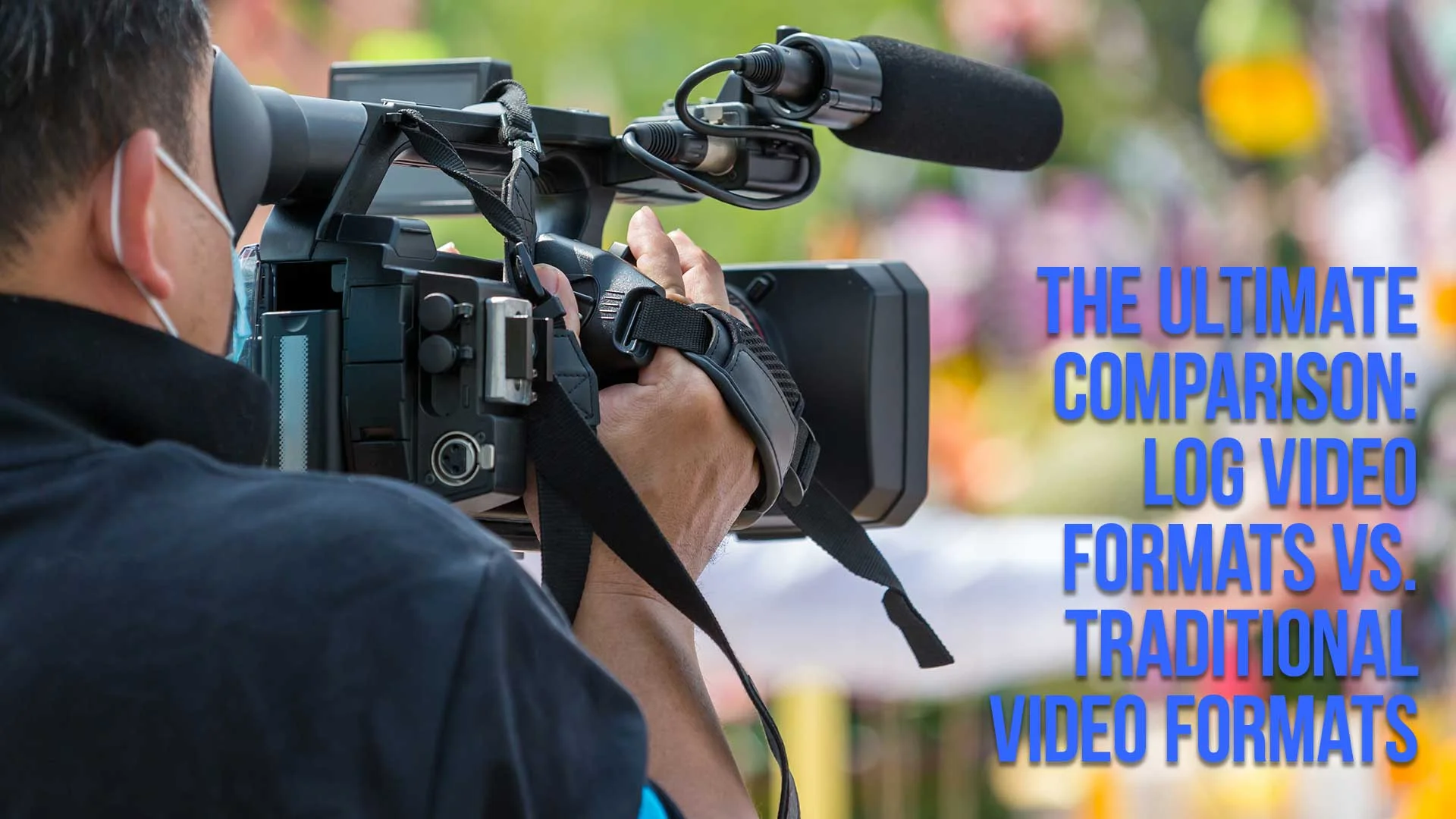Table of Contents
- What Are Log Video Formats?
- Traditional Video Formats: A Brief Overview
- Comparing Color Gamut And Dynamic Range
- Post-Production Flexibility
- The Learning Curve
- File Size And Storage
- When To Choose Log Video Formats
- When To Choose Traditional Video Formats
- Matching Log And Traditional Footage
- The Future Of Video Formats
- Log Vs Traditional Video Formats FAQ
What Are Log Video Formats?
Log video formats are an advanced approach to capturing video data that emphasizes dynamic range and flexibility in post-production.
They offer more control over color grading, preserving details in both highlights and shadows.
Traditional Video Formats: A Brief Overview
Traditional video formats, such as Rec. 709 or sRGB, focus on delivering a consistent look across devices by limiting dynamic range and color gamut.
This ensures compatibility and a standard look, but sacrifices creative flexibility.

Comparing Color Gamut and Dynamic Range
Log video formats boast a wider color gamut and dynamic range, allowing for richer colors and more detail in shadows and highlights.
Traditional video formats offer a smaller color gamut, which can result in less accurate colors and a reduced dynamic range.
Post-Production Flexibility
Log video formats provide more latitude in post-production, granting editors the freedom to experiment with color grading and exposure adjustments.
Traditional video formats offer less flexibility, as the baked-in color and contrast can limit creative choices.
The Learning Curve
Working with log video formats requires knowledge of color correction and grading techniques, as well as specialized software.
Traditional video formats are more user-friendly, as they don't require the same level of expertise.
File Size and Storage
Log video formats produce larger files due to the increased data captured. This can impact storage requirements and transfer times.
Traditional video formats generate smaller files, making them more manageable for storage and transfer.

When to Choose Log Video Formats
Consider using log video formats when you require flexibility in post-production, need to maximize dynamic range, or want to future-proof your footage for HDR displays.
When to Choose Traditional Video Formats
Opt for traditional video formats when ease of use is a priority, compatibility is essential, or when working with limited storage or bandwidth.
Matching Log and Traditional Footage
When combining log and traditional footage, color grading is essential to ensure a consistent look. This may require additional time and expertise in post-production.

The Future of Video Formats
As technology advances, the gap between log and traditional video formats will likely diminish, with improved dynamic range and color gamut in standard formats.
Until then, log video formats will continue to offer a superior choice for those seeking creative control.

Log vs Traditional Video Formats Frequently Asked Questions
What is the main advantage of using log video formats?
The primary advantage of log video formats is their increased dynamic range and color gamut, which allows for greater flexibility in post-production and more accurate color representation.
Do log video formats require specific hardware?
Log video formats often require specialized cameras and recording equipment capable of capturing the increased dynamic range and color information.
Are log video formats more expensive to work with?
While the initial cost of equipment may be higher, the added flexibility in post-production can save time and resources, potentially offsetting the increased expense.
Can you convert traditional video formats to log video formats?
Converting traditional video formats to log is not recommended, as the original footage lacks the necessary dynamic range and color information needed for accurate conversion.
How do I decide which video format to use?
Consider factors such as your project's budget, post-production requirements, and intended distribution method when deciding between log and traditional video formats.
What software is recommended for editing log video formats?
Professional video editing software, such as Adobe Premiere Pro, DaVinci Resolve, or Final Cut Pro, are recommended for working with log video formats.
Do log video formats affect video resolution?
No, log video formats primarily affect dynamic range and color gamut, not resolution.
Can log video formats be used for live broadcasting?
Log video formats are typically not suitable for live broadcasting, as they require additional color grading and processing that can't be done in real time. Traditional video formats are better suited for live broadcasting, as they provide a standardized and consistent look without the need for extensive post-production.
Are log video formats compatible with all devices?
Log video formats may not be compatible with all devices or display technologies. Before using log video formats, ensure that your intended playback devices and platforms support them.
Can I use both log and traditional video formats in the same project?
Yes, you can use both log and traditional video formats in the same project. However, it's important to color grade the footage to ensure a consistent look across all clips.

About the Author
Joseph Nilo has been working professionally in all aspects of audio and video production for over twenty years. His day-to-day work finds him working as a video editor, 2D and 3D motion graphics designer, voiceover artist and audio engineer, and colorist for corporate projects and feature films.
Parent Article:
Log Video Formats Reference Guide
Related Articles:
The Evolution of Log Video Formats
Demystifying Log Video Formats
Log Video Formats vs. Traditional Video Formats
Top 10 Log Video Format Cameras
Color Grading Techniques for Log Video Formats
The Impact of Log Video Formats on Modern Cinematography
Mastering Post-Production Workflows for Log Video Formats
Best Practices for Archiving and Storing Log Video Format Files
Video Editing Related Posts
Adobe Creative Cloud for Video Editing
Top 10 Video Editing Software for Mac
The Benefits of Dual-Monitor Setups for Video Editing
How to Choose the Right Video Editing Monitor for Your Needs
Best Monitors for Video Editing
Best Video Editing Software in 2023
Best Mac for Video Editing in 2023
(Almost) 50 Mistakes Every New Video Producer Makes
Breakthrough AI Tools: Elevate Your Video Production Game!
- What Are Log Video Formats?
- Traditional Video Formats: A Brief Overview
- Comparing Color Gamut And Dynamic Range
- Post-Production Flexibility
- The Learning Curve
- File Size And Storage
- When To Choose Log Video Formats
- When To Choose Traditional Video Formats
- Matching Log And Traditional Footage
- The Future Of Video Formats
- Log Vs Traditional Video Formats FAQ
Parent Article:
Log Video Formats Reference Guide
Related Articles:
The Evolution of Log Video Formats
Demystifying Log Video Formats
Log Video Formats vs. Traditional Video Formats
Top 10 Log Video Format Cameras
Color Grading Techniques for Log Video Formats
The Impact of Log Video Formats on Modern Cinematography
Mastering Post-Production Workflows for Log Video Formats
Best Practices for Archiving and Storing Log Video Format Files
Parent Article:
Log Video Formats Reference Guide
Related Articles:
The Evolution of Log Video Formats
Demystifying Log Video Formats
Log Video Formats vs. Traditional Video Formats
Top 10 Log Video Format Cameras
Color Grading Techniques for Log Video Formats
The Impact of Log Video Formats on Modern Cinematography
Mastering Post-Production Workflows for Log Video Formats
Best Practices for Archiving and Storing Log Video Format Files
